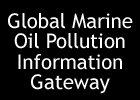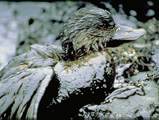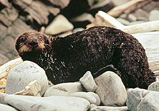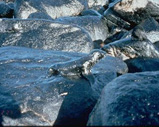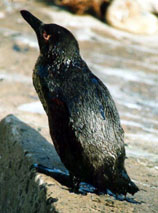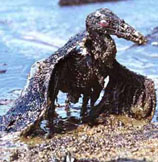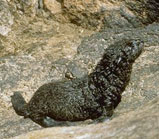After
Exxon Valdez spill, oiled duck and oiled sea otter. © Exxon
Valdez Oil Spill Trustee Council. After San Jorge spill,
off Uruguay, oiled, seal pup, See also below, oiled seal. ©
Tom Loughlin, NOAA.
After Treasure oil spill off South Africa: Oiled African penguin,
oil dripping off the plumage.© Avian Demography Unit, University
of Cape Town. Oiled bird, Brazil. © Guardian
Unlimited.
EFFECTS
 There is no clear relationship between the amount of oil
in the marine environment and the likely impact on wildlife.
A smaller spill at the wrong time/wrong season and in a
sensitive environment may prove much more harmful than a
larger spill at another time of the year in another or even
the same environment. Even small spills can have very large
effects. Thus, one should not merely compare figures —
the size of an oil spill is certainly not the only factor
of importance in terms of what environmental damage can
be caused by the oil.
There is no clear relationship between the amount of oil
in the marine environment and the likely impact on wildlife.
A smaller spill at the wrong time/wrong season and in a
sensitive environment may prove much more harmful than a
larger spill at another time of the year in another or even
the same environment. Even small spills can have very large
effects. Thus, one should not merely compare figures —
the size of an oil spill is certainly not the only factor
of importance in terms of what environmental damage can
be caused by the oil.
 In 1976, a spill estimated to have been less than 10 tonnes
killed more than 60,000 long-tailed ducks wintering in the
Baltic Sea and attracted to the seemingly calm water surface
created by the oil slick. This could be compared to the effects
on seabirds in Alaskan waters from the approximately 40,000
tonnes large Exxon Valdez oil spill in 1989, when an estimated
30,000 birds were oiled.
In 1976, a spill estimated to have been less than 10 tonnes
killed more than 60,000 long-tailed ducks wintering in the
Baltic Sea and attracted to the seemingly calm water surface
created by the oil slick. This could be compared to the effects
on seabirds in Alaskan waters from the approximately 40,000
tonnes large Exxon Valdez oil spill in 1989, when an estimated
30,000 birds were oiled.
 Another example from the waters off South
Africa: "There is rather little correlation between
the tonnages of oil released in spills and the impacts on
the marine ecosystems. For example, a collision between
two oil tankers in 1977 released 31,000 tonnes of oil and
polluted 47 African Penguins, but in the Apollo Sea
sinking of 1994, about 2,000 tonnes of oil impacted about
10,000 penguins. After the Apollo Sea, we generally
believed that this was the maximum amount of penguin mischief
that 2,000 tonnes of oil could achieve. However, when the
Treasure sank on 23 June 2000, half this amount of
oil threatened four times as many penguins! In round figures,
20,000 penguins were oiled, and 20,000 penguins were prevented
from becoming oiled by removing them off their breeding
colonies on Dassen and Robben Islands."
Another example from the waters off South
Africa: "There is rather little correlation between
the tonnages of oil released in spills and the impacts on
the marine ecosystems. For example, a collision between
two oil tankers in 1977 released 31,000 tonnes of oil and
polluted 47 African Penguins, but in the Apollo Sea
sinking of 1994, about 2,000 tonnes of oil impacted about
10,000 penguins. After the Apollo Sea, we generally
believed that this was the maximum amount of penguin mischief
that 2,000 tonnes of oil could achieve. However, when the
Treasure sank on 23 June 2000, half this amount of
oil threatened four times as many penguins! In round figures,
20,000 penguins were oiled, and 20,000 penguins were prevented
from becoming oiled by removing them off their breeding
colonies on Dassen and Robben Islands."
 As summarized by the Australian Maritime Safety Authority
(AMSA), important factors related to
the impact of an oil spill on wildlife are:
As summarized by the Australian Maritime Safety Authority
(AMSA), important factors related to
the impact of an oil spill on wildlife are:
- the
spread of the oil slick,
- the
type of oil spilled, its movement and weathering characteristics
- the
location of the spill,
- the
area of estuary, sea and foreshore impacted by oil,
- the
sensitivity of the regional environment, eg proximity
to bird breeding colony,
- the
number of different habitats impacted, such as rock shore,
beach, mangrove, wetland,
- the
timing of the incident (during seasonal breeding, bird
migration),
- the
nature, toxicity and persistence of the oil; and
- the
variety of species at the spill location.
 In the words of the U.S. Environmental Protection Agency (EPA):
"Most biological communities are susceptible to the effects
of oil spills. Plant communities on land, marsh grasses in estuaries,
and kelp beds in the ocean; microscopic plants and animals;
and larger animals, such as fish, amphibians and reptiles, birds
and mammals, are subject to contact, smothering, toxicity, and
the chronic long-term effects that may result from the physical
and chemical properties of the spilled oil."
In the words of the U.S. Environmental Protection Agency (EPA):
"Most biological communities are susceptible to the effects
of oil spills. Plant communities on land, marsh grasses in estuaries,
and kelp beds in the ocean; microscopic plants and animals;
and larger animals, such as fish, amphibians and reptiles, birds
and mammals, are subject to contact, smothering, toxicity, and
the chronic long-term effects that may result from the physical
and chemical properties of the spilled oil."
SEABIRDS
AND MARINE MAMMALS
Oil
harms seabirds and marine mammals in two major ways:
- Physical
contact — when fur or feathers come into contact
with oil;
- Toxic
contamination — some species are susceptible
to the toxic effects of inhaled or ingested oil. Oil vapours
can cause damage to an animal's central nervous system,
liver, and lungs. Animals are also at risk from ingesting
oil, which can reduce the animal's ability to eat or digest
its food by damaging cells in the intestinal tract. Some
studies show that there can also be long-term reproductive
problems in animals that have been exposed to oil.
SEABIRDS
 Oil may kill seabirds in several ways.
Oil may kill seabirds in several ways.
 The first effect is often that oil destroys the structure
of its protective layer of feathers and insulating down.
The fat under the birds skin is an energy reserve as well
as an extra layer of insulation. Cold water quickly penetrates
into the down and reaches the skin. The amount of oil that
a bird is smeared with is not important. In a cold climate
an oil spot the size of 2-3 sq. centimetre can be enough
to kill a bird. The insulating effect of the plumage is
destroyed by the oil, and the bird freezes to death (hypothermia).
If a bird gets smeared with a lot of oil it may clog the
bird's feathers making it impossible for it to fly. The
bird may also loose it buoyancy (its ability to float on
the water surface) and actually drown.
The first effect is often that oil destroys the structure
of its protective layer of feathers and insulating down.
The fat under the birds skin is an energy reserve as well
as an extra layer of insulation. Cold water quickly penetrates
into the down and reaches the skin. The amount of oil that
a bird is smeared with is not important. In a cold climate
an oil spot the size of 2-3 sq. centimetre can be enough
to kill a bird. The insulating effect of the plumage is
destroyed by the oil, and the bird freezes to death (hypothermia).
If a bird gets smeared with a lot of oil it may clog the
bird's feathers making it impossible for it to fly. The
bird may also loose it buoyancy (its ability to float on
the water surface) and actually drown.
 In their efforts to clean themselves from oil and put their
feathers in their original state, the birds may inhale or
ingest oil. As many of the substances in oil are toxic,
this may result in serious injuries/health effects such
as pneumonia, congested lungs, intestinal or lung hemorrhage,
liver and kidney damage. This poisoning is often as deadly
as hypothermia, although the effects may not manifest themselves
as quickly.
In their efforts to clean themselves from oil and put their
feathers in their original state, the birds may inhale or
ingest oil. As many of the substances in oil are toxic,
this may result in serious injuries/health effects such
as pneumonia, congested lungs, intestinal or lung hemorrhage,
liver and kidney damage. This poisoning is often as deadly
as hypothermia, although the effects may not manifest themselves
as quickly.
 Oil may also affect the reproductive success of the birds
as oil from feathers of a bird that is laying on eggs may
pass through the pores in the eggshells and either kill the
embryos or lead to malformations.
Oil may also affect the reproductive success of the birds
as oil from feathers of a bird that is laying on eggs may
pass through the pores in the eggshells and either kill the
embryos or lead to malformations.
MARINE
MAMMALS
 Seals, sea lions, walruses, polar bears, sea otters, river
otters, beavers, whales, dolphins and porpoises, and manatees,
are groups of marine mammals that may be affected by oil
spills. Their sensitivity seems to be highly variable and
appear to be most directly connected to how important their
fur and blubber (layer of fat under the skin) are for keeping
them warm. Thus, marine mammals living in cold climates
(seals, sea lions, polar bears and otters) are likely to
be more vulnerable than those living in temperate or tropical
waters.
Seals, sea lions, walruses, polar bears, sea otters, river
otters, beavers, whales, dolphins and porpoises, and manatees,
are groups of marine mammals that may be affected by oil
spills. Their sensitivity seems to be highly variable and
appear to be most directly connected to how important their
fur and blubber (layer of fat under the skin) are for keeping
them warm. Thus, marine mammals living in cold climates
(seals, sea lions, polar bears and otters) are likely to
be more vulnerable than those living in temperate or tropical
waters.
 Effects of oil on marine mammals depend upon species may,
in addition to hypothermia, include: toxic effects and secondary
organ dysfunction due to ingestion of oil; congested lungs;
damaged airways; interstitial emphysema due to inhalation
of oil droplets and vapour; gastrointestinal ulceration
and hemorrhaging due to ingestion of oil during grooming
and feeding; eye and skin lesions from continuous exposure
to oil; decreased body mass due to restricted diet; and
stress due to oil exposure and behavioural changes.
Effects of oil on marine mammals depend upon species may,
in addition to hypothermia, include: toxic effects and secondary
organ dysfunction due to ingestion of oil; congested lungs;
damaged airways; interstitial emphysema due to inhalation
of oil droplets and vapour; gastrointestinal ulceration
and hemorrhaging due to ingestion of oil during grooming
and feeding; eye and skin lesions from continuous exposure
to oil; decreased body mass due to restricted diet; and
stress due to oil exposure and behavioural changes.
Seals
(true seals, sea lions, fur
seals and walruses)
 Seals are very vulnerable to oil pollution because they
spend much of their time on or near the surface of the water.
They need to surface to breathe, and regularly haul out
onto beaches. During the course of an oil pollution incident,
they are at risk both when surfacing and when hauling out.
Seals are very vulnerable to oil pollution because they
spend much of their time on or near the surface of the water.
They need to surface to breathe, and regularly haul out
onto beaches. During the course of an oil pollution incident,
they are at risk both when surfacing and when hauling out.
 Fur seals are more vulnerable due to the likelihood of oil
adhering to their fur which will result in the fur losing
its insulating ability (as they lack any blubber for additional
insulation). Heavy oil coating on fur seals may result in
reduced swimming ability and lack of mobility when the seals
are on land.
Fur seals are more vulnerable due to the likelihood of oil
adhering to their fur which will result in the fur losing
its insulating ability (as they lack any blubber for additional
insulation). Heavy oil coating on fur seals may result in
reduced swimming ability and lack of mobility when the seals
are on land.
 Seals could also be damaged through the ingestion of oiled
food or the inhalation of oil droplets and vapours. Oil,
especially light oils and hydrocarbon vapours, will attack
exposed sensitive tissues. These include mucous membranes
that surround the eyes and line the oral cavity, respiratory
surfaces, anal and urogenital orifices. This can cause corneal
abrasions, conjunctivities and ulcers. Consumption of oil-contaminated
prey could lead to the accumulation of hydrocarbons in tissues
and organs.
Seals could also be damaged through the ingestion of oiled
food or the inhalation of oil droplets and vapours. Oil,
especially light oils and hydrocarbon vapours, will attack
exposed sensitive tissues. These include mucous membranes
that surround the eyes and line the oral cavity, respiratory
surfaces, anal and urogenital orifices. This can cause corneal
abrasions, conjunctivities and ulcers. Consumption of oil-contaminated
prey could lead to the accumulation of hydrocarbons in tissues
and organs.
Sea
otters
 Sea otters spend a lot of their time on the sea surface
and are totally depending on their fur for isolation and
for the ability to float. As a consequence, sea otters are
regarded as being very sensitive to oil spills as oil may
result in the fur losing its capacity to insulate the animals.
However, inhaling hydrocarbons or ingesting oil when they
groom themselves can damage their lungs, cause ulcers, and
result in liver and kidney damage. Habitat loss and diminishing
food resources constitute indirect effects on the otters.
The Exxon Valdez incident is believed to have led
to the death of 15,000 otters, mainly as a result of ingestion
of oil.
Sea otters spend a lot of their time on the sea surface
and are totally depending on their fur for isolation and
for the ability to float. As a consequence, sea otters are
regarded as being very sensitive to oil spills as oil may
result in the fur losing its capacity to insulate the animals.
However, inhaling hydrocarbons or ingesting oil when they
groom themselves can damage their lungs, cause ulcers, and
result in liver and kidney damage. Habitat loss and diminishing
food resources constitute indirect effects on the otters.
The Exxon Valdez incident is believed to have led
to the death of 15,000 otters, mainly as a result of ingestion
of oil.
Polar bears
 Polar bears are depending on blubber, so called guard hair
and a thick underfur for insulation. When grooming an oil
contaminated fur they may swallow oil, something that is
known to have resulted in the death of polar bears. There
is also some evidence that the toxic effects of oil cause
an inability of polar bears to produce red blood cells and
lead to kidney damage.
Polar bears are depending on blubber, so called guard hair
and a thick underfur for insulation. When grooming an oil
contaminated fur they may swallow oil, something that is
known to have resulted in the death of polar bears. There
is also some evidence that the toxic effects of oil cause
an inability of polar bears to produce red blood cells and
lead to kidney damage.
Whales,
including dolphins
 Due to their migratory behaviour, there is little documented
evidence of cetaceans (whales) being affected by oil spills.
It would, however seem likely that baleen whales would be
particularly vulnerable to oil while feeding. Oil may stick
to the baleens while the whales "filter feed"
in the vicinity of oil slicks. They plunge, take in huge
quantities of water and then filter out their feed of plankton
and krill. Sticky, tar-like residues are then particularly
likely to foul their baleen plates. There are also indications
that whales can inhale droplets of oil, vapours and fumes
if they surface in slicks when they need to breathe. Exposure
to oil in this way could lead to damage of mucous membranes,
injuries in airways or even cause death.
Due to their migratory behaviour, there is little documented
evidence of cetaceans (whales) being affected by oil spills.
It would, however seem likely that baleen whales would be
particularly vulnerable to oil while feeding. Oil may stick
to the baleens while the whales "filter feed"
in the vicinity of oil slicks. They plunge, take in huge
quantities of water and then filter out their feed of plankton
and krill. Sticky, tar-like residues are then particularly
likely to foul their baleen plates. There are also indications
that whales can inhale droplets of oil, vapours and fumes
if they surface in slicks when they need to breathe. Exposure
to oil in this way could lead to damage of mucous membranes,
injuries in airways or even cause death.
 Dolphins are smooth-skinned, hairless mammals, and as a
consequence oil tends not to stick to their skin, but they
can inhale oil and oil vapour. This is most likely to occur
when they surface to breathe. This may lead to damages of
the airway and lungs, mucous membrane damage or even death.
A stressed or panicking dolphin would move faster, breathe
more rapidly and therefore surface more frequently into
oil which would increase exposure. Dolphins eyesight may
also be affected by oil.
Dolphins are smooth-skinned, hairless mammals, and as a
consequence oil tends not to stick to their skin, but they
can inhale oil and oil vapour. This is most likely to occur
when they surface to breathe. This may lead to damages of
the airway and lungs, mucous membrane damage or even death.
A stressed or panicking dolphin would move faster, breathe
more rapidly and therefore surface more frequently into
oil which would increase exposure. Dolphins eyesight may
also be affected by oil.
Manatees
and dugongs
 Manatees and dugongs live in warm waters and have a layer
of blubber as insulation. Thus, the impact of oil on their
body temperature might not be of importance. However, as
all marine mammals they may be affected when they inhale
volatile hydrocarbons when breathing on the water surface.
Manatees and dugongs live in warm waters and have a layer
of blubber as insulation. Thus, the impact of oil on their
body temperature might not be of importance. However, as
all marine mammals they may be affected when they inhale
volatile hydrocarbons when breathing on the water surface.
TURTLES,
FISH AND SHELLFISH
Sea turtles
 Little information is available on the effects of oil on
sea turtles. However, a number of effects have been suggested
as possible.
Little information is available on the effects of oil on
sea turtles. However, a number of effects have been suggested
as possible.
 If turtles surface in an oil slick to breathe, oil will
affect their eyes and damage airways and/or lungs. Sea turtles
could also be affected by oil through contamination of food
supply or by absorption through the skin.
If turtles surface in an oil slick to breathe, oil will
affect their eyes and damage airways and/or lungs. Sea turtles
could also be affected by oil through contamination of food
supply or by absorption through the skin.
 The nesting sites of sea turtles are typically located on
sandy beaches. Oil contamination of such beaches can lead
to several problems:
The nesting sites of sea turtles are typically located on
sandy beaches. Oil contamination of such beaches can lead
to several problems:
- Digestion/absorption
of oil through food contamination or direct physical contact,
leading to damage to the digestive tract and other organs;
- Irritation
of mucous membranes (such as those in the nose, throat
and eyes) leading to inflammation and infection;
- Eggs
may be contaminated, either because there is oil in the
sand high up on the beach at the nesting site, or because
the adult turtles are oiled as they make their way across
the oiled beach to the nesting site, and oiling of eggs
may inhibit their development;
- Newly
hatched turtles, after emerging from the nests, make their
way over the beach to the water and may become oiled.
Fish
and shellfish
 Fish may ingest large amounts of oil through their gills.
Fish that have been exposed to oil may suffer from changes
in heart and respiratory rate, enlarged livers, reduced
growth, fin erosion and a variety of effects at biochemical
and cellular levels. If this does not kill them more or
less directly, the oil may affect the reproductive capacity
negatively and/or result in deformed fry.
Fish may ingest large amounts of oil through their gills.
Fish that have been exposed to oil may suffer from changes
in heart and respiratory rate, enlarged livers, reduced
growth, fin erosion and a variety of effects at biochemical
and cellular levels. If this does not kill them more or
less directly, the oil may affect the reproductive capacity
negatively and/or result in deformed fry.
 Much less is known about the effects of oil on fish eggs
and larvae. The large proportion of salmon eggs killed off
by the Exxon Valdez spill indicate that the effects
can be serious and long-term.
Much less is known about the effects of oil on fish eggs
and larvae. The large proportion of salmon eggs killed off
by the Exxon Valdez spill indicate that the effects
can be serious and long-term.
 Very little is also known about the effects of oil on shellfish
(except for the fact that contamination with hydrocarbons
will make shellfish taste and smell bad and thus make it
impossible to use them for food).
Very little is also known about the effects of oil on shellfish
(except for the fact that contamination with hydrocarbons
will make shellfish taste and smell bad and thus make it
impossible to use them for food).
RECOVERY
 The negative effects of on oil spill may eventually fade away,
but in many cases it will be matter of several years, even
decades, before an area or ecosystem has fully recovered from
a spill that caused extensive damages. Every situation is
unique and depending on the particular conditions and circumstances
in that area, and on the characteristics of the spill. Some
areas might recover in a matter of weeks, others will need
up to 20 years. The recovery of an ecosystem will also depend
on the share of important populations being killed off or
affected by acute poisoning.
The negative effects of on oil spill may eventually fade away,
but in many cases it will be matter of several years, even
decades, before an area or ecosystem has fully recovered from
a spill that caused extensive damages. Every situation is
unique and depending on the particular conditions and circumstances
in that area, and on the characteristics of the spill. Some
areas might recover in a matter of weeks, others will need
up to 20 years. The recovery of an ecosystem will also depend
on the share of important populations being killed off or
affected by acute poisoning.
 The recovery of the affected habitats and species following
an oil spill will to a large extent depend on the type of
ecosystem , the vulnerability of the species and not least
the climate of the region where the oil spill occurs. Generally,
recovery will proceed faster in warmer climates and on rocky
shores compared to cold climates and, for example, marshes.
The long-term effects on deeper bottoms (i.e., if oil sinks
and is absorbed in bottom sediments) is also a matter of concern.
The recovery of the affected habitats and species following
an oil spill will to a large extent depend on the type of
ecosystem , the vulnerability of the species and not least
the climate of the region where the oil spill occurs. Generally,
recovery will proceed faster in warmer climates and on rocky
shores compared to cold climates and, for example, marshes.
The long-term effects on deeper bottoms (i.e., if oil sinks
and is absorbed in bottom sediments) is also a matter of concern.
 The best documented evidence concerning the recovery of ecosystems
affected by massive oil pollution are from the Persian Gulf
and resulting from the discharges associated with the Gulf
War in 1991. Studies (GESAMP) suggest
that the chronic and acute releases that took place were rather
rapidly accommodated by the system. Already at the end of
1992, researchers reported that many of the worst hit beaches
in Saudi Arabia were almost clean of oil. It is believed that
this may have been the result of the warm water of the Gulf
and the fact that its bacterial populations were able to degrade
and weather the oil much more quickly than previously believed
to be possible.
The best documented evidence concerning the recovery of ecosystems
affected by massive oil pollution are from the Persian Gulf
and resulting from the discharges associated with the Gulf
War in 1991. Studies (GESAMP) suggest
that the chronic and acute releases that took place were rather
rapidly accommodated by the system. Already at the end of
1992, researchers reported that many of the worst hit beaches
in Saudi Arabia were almost clean of oil. It is believed that
this may have been the result of the warm water of the Gulf
and the fact that its bacterial populations were able to degrade
and weather the oil much more quickly than previously believed
to be possible.
 The experience gained from the Exxon Valdez spill
has been documented, and could serve as one example of what
happens in the aftermath of a major spill in a sensitive
area. See, for example, the web site of the Exxon
Valdez Oil Spill Trustee Council, and NOAA
Office of Response and Restoration ("NOAA biologists
have been monitoring the long-term effects of the spill
and cleanup efforts. Here are some of their reports, along
with links to more information elsewhere").
The experience gained from the Exxon Valdez spill
has been documented, and could serve as one example of what
happens in the aftermath of a major spill in a sensitive
area. See, for example, the web site of the Exxon
Valdez Oil Spill Trustee Council, and NOAA
Office of Response and Restoration ("NOAA biologists
have been monitoring the long-term effects of the spill
and cleanup efforts. Here are some of their reports, along
with links to more information elsewhere").
|
